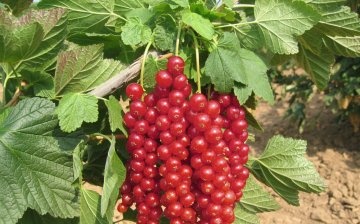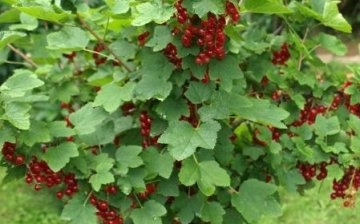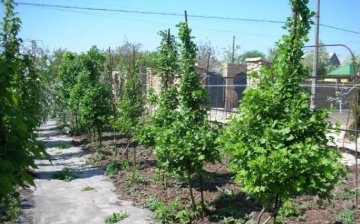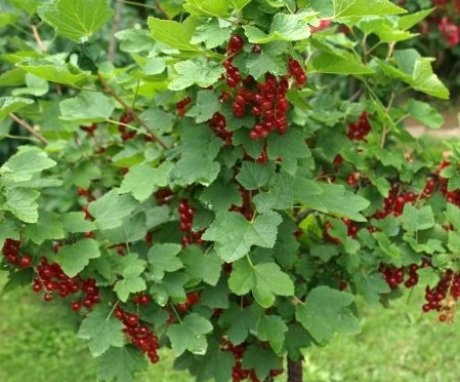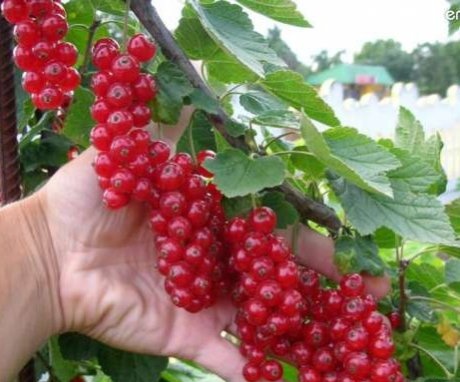How to properly grow a standard currant and care for it
In order to get the maximum yield of currants and prolong its fertile age, it is necessary to properly care for it. Proper care includes planting, pruning in time, feeding with nutrients and providing the plant with maximum protection from pests.
Content:
Standard currant care
Pruning of currant bush begins in the autumn after the plant has dropped the deciduous cover.
At this time, dried, diseased and thickened shoots are cut out. It is not at all difficult to identify unnecessary shoots, they have a coarse and darkened bark, and some are completely dry.
Considerable attention should be paid to newly planted plants:
- Care should be taken to ensure that the root system is well developed. For this purpose, the one-year plant during pruning leave 2-3 buds.
- Further, the pruning forming the bush continues for 3 years.
- You can form a currant bush at your discretion, giving it not only the appearance of a beautiful bush of various shapes, but also the appearance of a beautiful tree. Such a tree is called standard.
Gardeners are increasingly resorting to growing shrub plants in standard form, confirmation of this is the numerous responses on the forums of gardeners.
Formation of the trunk
It is not difficult to grow standard currants; for this you do not need to resort to various vaccinations... The standard shape can be given to any shrub. By marking trees along the paths or along the house, you can get not only a useful fruiting alley, but also an unusual decorative decoration for your garden.
Standard currants begin to form already at the time of planting.
When a shrub is formed, the seedling is planted with a slight slope, which contributes to the development of a powerful root system and the aerial part of the plant.
Landing tricks:
- Unlike shrub planting, standard currants are planted straight, without tilting to prevent the development of basal shoots.
- Before planting, the root collar of the seedling is cleared of all buds and additional shoots.
- Removal of buds is also carried out on the entire shoot at the level selected for the trunk. For example, the height of a biennial currant stem can reach 40 cm, and for a young seedling it is 20-25 cm.
- Next, you should take care of the formation of the crown of the standard plant.
To force a seedling develop the crown in its upper part, pinch its top. The pinching operation is performed in the spring or summer. The next year, the seedling will start up side shoots, they should also be pinched over 2 or 3 leaves.
In the third year of the formation of the stem, all shoots are subjected to pinching, the length of which is more than 10 cm.
This year the plant will bear its first fruits. In the future, pinching is carried out annually, at the same time removing the shoots that appear below the level of the trunk. The yield of the plant will be much more plentiful, but abundant fruiting will not last for a very long period of time, approximately until the currants reach 7 years of age.
Advantages and disadvantages of the standard form
Punching has a number of advantages:
- A stalk that has a single bud on its crown can serve as a seedling for a stem.
- A more accurate crown of the plant is formed, allowing neighboring bushes to be planted at a distance of 30 cm from each other.
- Plant care is greatly facilitated.
- Fruiting branches will not fall on the ground, therefore, the fruits will hurt and deteriorate much less.
- It is easier to protect a standard plant from attacks of pests living in the ground.
- It becomes possible to use the garden area as useful as possible by planting all kinds of shade-loving plants under a trunk.
- There is no consumption of nutrients and vitamins for the formation of excess basal shoots.
- Harvesting is greatly facilitated.
- The berries of the standard currant are better illuminated and, as a result, have a brighter pronounced taste.
- The life span of a standard plant can reach 15-18 years, which is undoubtedly more than that of a shrub-shaped plant.
- The decorative appearance of the plant leaves no one indifferent.
Negative sides:
- The tall shoot of the trunk is poorly and not completely wrapped in snow.
- Poor protection of the standard plant from strong winds.
- Possible damage to the standard branch in the winter period of time by frost.
- Periodic timely pinching and cutting of unnecessary shoots.
- The productivity of a standard plant reaches its peak by the age of 6-7 years and sharply decreases due to the absence of rooted shoots.
- Uprooting a standard plant at the age of 7 brings some inconvenience.
- There is no possibility of replacing a worn-out branch with a young and strong shoot.
More information can be found in the video.



